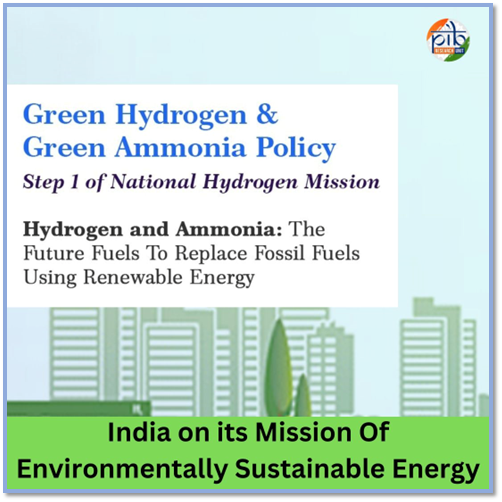

Green Hydrogen has emerged as a promising prospect as the world moves toward cleaner and sustainable energy solutions. Harnessed from renewable sources, Green Hydrogen is considered and used as a cleaner alternative to fossil fuels and has the potential to revolutionise sectors like transportation, industry, and energy production.
In this comprehensive guide, let us explore Green Hydrogen, how it’s produced, its applications, and the ambitious steps India is taking to become a global leader in this field.
What is Green Hydrogen?
Green Hydrogen is a scientific name that refers to hydrogen that is produced or generated while utilising renewable energy sources, such as wind or solar power, especially through a process called electrolysis. This clean-burning fuel has no carbon emissions, which makes it a key player in combating climate change. Unlike traditional hydrogen, which is often obtained from fossil fuels (grey hydrogen) or uses carbon capture methods (blue hydrogen), Green Hydrogen leaves no carbon footprint, this unique feature aligns with the global efforts to transition to a low-carbon economy.
How Green Hydrogen is Produced
Understanding how green hydrogen is produced is vital to appreciating its potential benefits. Green Hydrogen production relies mainly on electrolysis, a process that splits water molecules (H₂O) into hydrogen (H₂) and oxygen (O₂) using electricity sourced from renewable energy like solar, wind, or hydropower.

Green Hydrogen is extracted while utilising such processes that ensure, no carbon emissions will be generated, as compared to traditional extraction practices and to resist conventional hydrogen production methods. To understand how green hydrogen is produced comprehensively, it’s essential to examine the method that sets it apart from other types of hydrogen production:
- Electrolysis is the primary method used for green hydrogen production. The electrolysis process involves passing an electric current through water to separate it into hydrogen and oxygen. When the electricity used in this process is sourced from renewable energy, like wind, solar, or hydroelectric power, the hydrogen produced is termed "green."
- Water and Renewable Power Sources : In this process, the only inputs are water and renewable electricity, which in in-turn produce no harmful emissions. The Green Hydrogen Policy in India emphasizes renewable energy use in hydrogen production to achieve the country’s net-zero emissions goal by 2070.
- Solar and Wind Power : Renewable sources like solar and wind generate the electricity needed for electrolysis, reducing reliance on fossil fuels.
Uses of Green Hydrogen
The uses of Green Hydrogen range in various sectors due to its versatility and environmental benefits. Some of the most significant uses include:
- Transportation : Green Hydrogen is a type of clean fuel that can be used in hydrogen fuel cell vehicles like buses, trucks, and trains. It offers longer ranges and quicker refuelling times than electric vehicles.
- Power Generation : Green Hydrogen can store excess renewable energy generated by solar or wind farms and, when needed, be converted back into electricity during peak demand.
- Industrial Applications : Heavy industries like steel, cement, and chemical manufacturing use high-temperature processes traditionally powered by fossil fuels. Green Hydrogen can function as a cleaner alternative, helping these industries reduce their carbon footprint.
- Grid Stabilization : Green Hydrogen is a storage medium for excess energy, ensuring a stable power supply when renewable sources are inconsistent.
- Power Generation : Green hydrogen can be used as a fuel in power plants, potentially replacing natural gas and contributing to a clean and flexible power grid.
- Heating : Hydrogen can be utilised to heat residential and commercial buildings, reducing the dependency on natural gas for heating purposes.
Advantages and Disadvantages of Green Hydrogen
Green hydrogen carries transformative potential while reducing greenhouse gas emissions and promoting sustainable energy solutions. However, despite its many benefits, it also faces specific economic and infrastructure challenges impacting its large-scale adoption. Here is a closer look at the advantages and disadvantages of green hydrogen in a summarized table:
| Advantages of Green Hydrogen | Disadvantages of Green Hydrogen |
| Zero Carbon Emissions : Produces no CO₂, contributing to climate change mitigation. | High Production Costs : Electrolysis and renewable infrastructure are costly, making Green Hydrogen less economically viable. |
| Energy Storage : Can store renewable energy, ensuring grid stability and energy supply during low renewable generation periods. | Infrastructure Requirements : Hydrogen transport, storage, and distribution require specialized infrastructure, posing logistical challenges. |
| Decarbonization of Hard-to-Abate Sectors : Offers a cleaner alternative for industries like steel and cement, where renewable energy alone may not be feasible. | High Water Demand : Requires substantial water, raising concerns in arid regions or water-stressed areas. |
| Enhanced Energy Security : Reduces dependence on fossil fuel imports and promotes local energy production. | Energy Intensive : Electrolysis consumes significant energy, potentially impacting cost and scalability if renewable energy sources are insufficient. |
Green Hydrogen Production in India
India has extensive potential for Green Hydrogen production, which is made possible only because of renewable energy resources, particularly solar power. The Indian government aims to transform India into a Green Hydrogen hub by capitalising on these renewable assets and reducing dependence on imported oil and gas.
The government of India aims to transform India into an energy-independent country by 2047 and achieve net-zero emissions by 2070. Green hydrogen has become a pillar of India's energy transition strategy .
- National Green Hydrogen Mission : In 2023, India launched the National Green Hydrogen Mission , which aspires to scale up domestic Green Hydrogen production and reduce costs. The mission seeks to create a capacity of 5 million tonnes per year by 2030 , positioning India as a global Green Hydrogen market leader.
- Renewable Energy Integration : India is expanding its solar and wind energy capacities to provide the foundation for large-scale Green Hydrogen production, enabling a cleaner, more self-sufficient energy system.
- Export Potential : With its cost-effective renewable energy resources, India has the potential to become a significant exporter of Green Hydrogen, meeting the demands in Europe and East Asia.
National Green Hydrogen Mission
India’s National Green Hydrogen Mission was approved by the Union Cabinet on January 4, 2022 , to position the nation as a global leader in Green Hydrogen production. This mission sets ambitious targets to create a substantial hydrogen ecosystem to generate employment and enhance investments. Here are the k ey objectives and outcomes expected by 2030:
Mission Objectives
- Global Leadership : Making India a leading global producer and supplier of Green Hydrogen.
- Export Opportunities : Opening up export channels for Green Hydrogen and its derivatives which will boost India's position in the international clean fuel market.
- Reduced Fossil Fuel Dependence : Minimizing reliance on imported fossil fuels and feedstock, while enhancing India’s energy security.
- Manufacturing Capabilities : Promoting indigenous production of electrolysis equipment and other Green Hydrogen infrastructure.
- Economic Development and Jobs : Generating employment and economic growth on a large scale by attracting investments and supporting R&D projects.
- Industrial Investment : Facilitating investment opportunities for industries keen on transitioning to cleaner energy.
Mission Outcomes by 2030
- Production Capacity : Developing a Green Hydrogen production capacity of at least 5 MMT (Million Metric Tonnes) per annum, with an associated renewable energy capacity addition of approximately 125 GW.
- Investment and Employment : Attracting over Rs. Eight lakh crore in investments and creating more than six lakh jobs in the clean energy sector.
- Reduced Fossil Fuel Imports : Reducing fossil fuel imports by over Rs. One lakh crore , contributing to economic resilience.
- Emissions Reduction : Achieving an annual greenhouse gas emissions reduction of approximately 50 MMT , significantly enhancing India’s climate commitments.
Green Hydrogen Policy India
The Prime Minister launched the Green Hydrogen Policy in India on India’s 75th Independence Day. The policy aims to support the Green Hydrogen Mission and scale up production while promoting an environment conducive to hydrogen’s adoption as a mainstream energy source.

- Incentives for Production : The policy offers tax breaks and financial support for Green Hydrogen production, which will reduce costs and make it competitive with other fuels.
- Renewable Energy Access : Producers receive access to renewable energy sources, allowing them to power electrolysis plants directly from solar or wind energy.
- Reduced Import Duties : This policy reduces import tariffs on essential equipment while facilitating the establishment of Green Hydrogen infrastructure.
- Grid Priority : Producers of Green Hydrogen can access the grid at priority rates, ensuring a reliable supply of renewable electricity for production.
Future of Green Hydrogen in India and Beyond
India’s Green Hydrogen Mission has set the foundation for the nation’s long-term transition to sustainable energy. By focusing on large-scale production and R&D, the government aims to overcome cost and infrastructure barriers, making Green Hydrogen a viable solution for domestic use and export.
Global demand for Green Hydrogen is rising, particularly in Europe and Asia, which is positioning India as a potential major exporter. Because of cost-effective renewable energy resources and supportive policies, India has the potential to play a significant role in the international Green Hydrogen market, which will create economic opportunities and advance climate goals.
Conclusion
Green Hydrogen stands at the forefront of India’s journey toward energy independence and carbon neutrality. With the National Green Hydrogen Mission and strong policy support, India is well on its way to becoming a global leader in this clean fuel. Although challenges like high production costs and infrastructure needs remain, the potential advantages make Green Hydrogen an essential element of India’s sustainable future.
Looking for guidance in UPSC preparation? Enroll in the UPSC courses offered by Physics Wallah!
| UPSC Related Articles | ||
| UPSC Prelims Questions | NCERT for UPSC Exam 2025 | UPSC Mains Admit Card |
| UPSC Mains Exam Pattern | UPSC Scholarship Test | UPSC Result |
Green Hydrogen FAQs
Q1. What is Green Hydrogen?
Q.2 What is the difference between Green Hydrogen and Blue Hydrogen?
Q.3 What are the 4 types of hydrogen?
Q.4 Is Hydrogen 100% green?
Q5. What are the disadvantages of Green Hydrogen?
Q.6 Who is the largest producer of Green Hydrogen?












